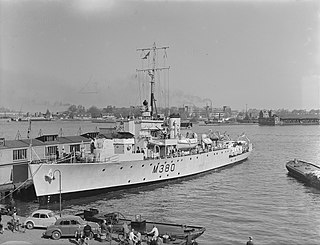
HMS Mariner was a reciprocating engine-powered Algerine-class minesweeper during the Second World War. Laid down as HMCS Kincardine for the Royal Canadian Navy she was transferred on completion to the Royal Navy as HMS Mariner. She survived the war and was sold to Myanmar in 1958 as Yang Myo Aung.
HMS Ossory was a reciprocating engine-powered Algerine-class minesweeper built for the Royal Navy during the Second World War. She commissioned too late for service in the conflict, but was in service during the Cold War period. She was scrapped in 1959.

HMS Maenad was a reciprocating engine-powered Algerine-class minesweeper built for the Royal Navy during the Second World War. She survived the war and was scrapped in 1957.

HMS Hydra was a reciprocating engine-powered Algerine-class minesweeper built for the Royal Navy during the Second World War. She was badly damaged during the war and was scrapped in 1947.
HMS Postillion was a reciprocating engine-powered Algerine-class minesweeper during the Second World War. She was ordered for the United States Navy as USS AM 335, but was transferred on completion under Lend-Lease to the Royal Navy as Postillion. She survived the war and was returned to the USN, being sold to the Greek Navy in 1947.
HMCyS Vijaya, named in honor of Vijaya, the first king of Sri Lanka, was an Algerine-class minesweeper of the Royal Ceylon Navy, the first warship of that navy. Vijaya had been built as HMS Flying Fish (J370) for the Royal Navy during World War II, but was given to Ceylon by the United Kingdom upon the 1951 formation of Ceylon's navy.

HMS Providence was a reciprocating engine-powered Algerine-class minesweeper during the Second World War. Laid down as HMCS Forrest Hill for the Royal Canadian Navy she was transferred on completion to the Royal Navy as HMS Providence. She survived the war and was scrapped in 1958.
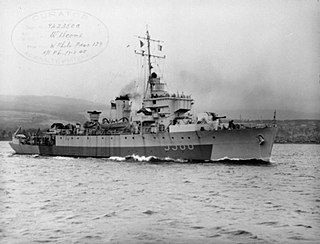
HMS Welcome was a reciprocating engine-powered Algerine-class minesweeper built for the Royal Navy during the Second World War. She survived the war and was scrapped in 1962.

HMS Hound was a reciprocating engine-powered Algerine-class minesweeper built for the Royal Navy during the Second World War. She survived the war and was scrapped in 1962.
HMS Wave was a reciprocating engine-powered Algerine-class minesweeper built for the Royal Navy during the Second World War. She survived the war and was scrapped, in 1962.
HMS Minstrel (J445) was a reciprocating engine-powered Algerine-class minesweeper during the Second World War. She survived the war and was sold to Thailand in 1947 as HTMSPhosamton(MSF-1).
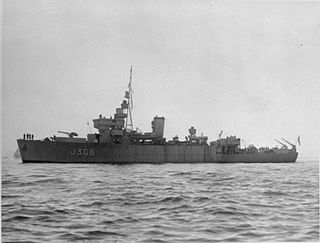
HMS Fly (J306) was a reciprocating engine-powered Algerine-class minesweeper during the Second World War. She survived the war and was sold to Iran in 1949 as IISPalang.

HMS Larne (J274) was a reciprocating engine-powered Algerine-class minesweeper during the Second World War. She survived the war and was sold to Italy in 1947 as Alabarda(F 560).

HMS Spanker (J226) was a steam turbine-powered Algerine-class minesweeper during the Second World War. She survived the war and was sold to Belgium in 1953 as De Brouwer (M904).
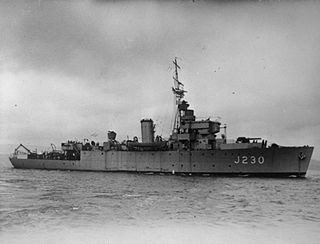
HMS Cadmus (J230) was a steam turbine-powered Algerine-class minesweeper during the Second World War. Launched in 1942 the ship survived the war and was sold to Belgium in 1950 as Georges Lecointe (M901).

HMS Cheerful (J388) was a steam turbine-powered Algerine-class minesweeper during the Second World War.

HMS Felicity (J369) was a reciprocating engine-powered Algerine-class minesweeper during the Second World War.

HMS Lennox (J276) was a reciprocating engine-powered Algerine-class minesweeper during the Second World War.

HMS Niger (J442) was a reciprocating engine-powered Algerine-class minesweeper during the Second World War.
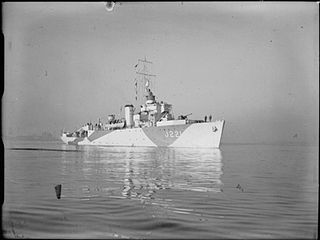
HMS Onyx (J221) was a steam turbine-powered Algerine-class minesweeper during the Second World War.















